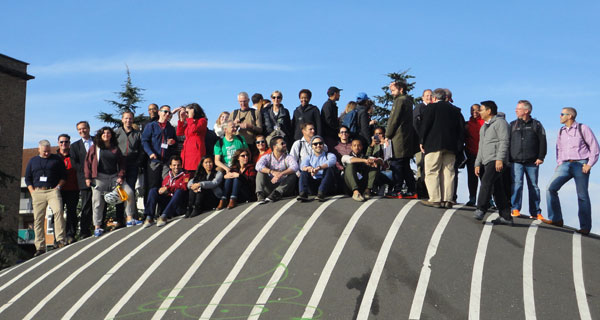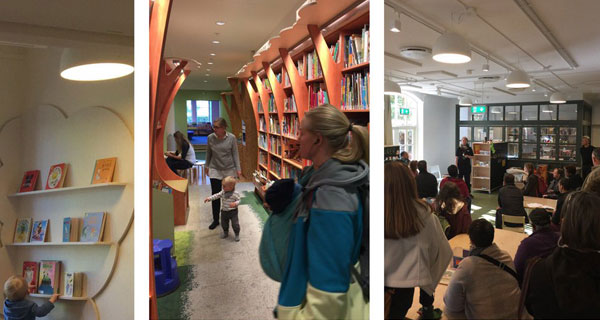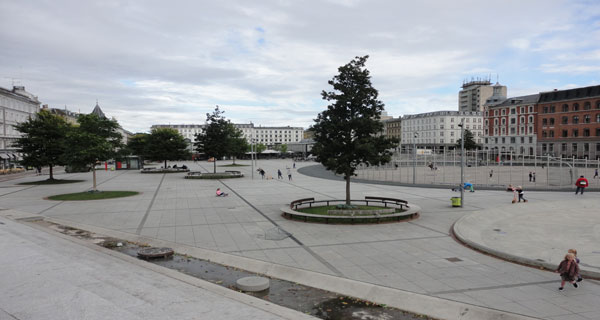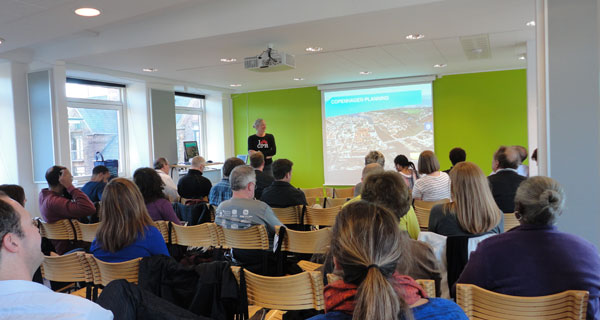26 Oct 8 80 Cities in Copenhagen
Copenhagen is a special city. Of all the places in the world, it’s the one city we host a study tour for city leaders year after year, thanks to the generous support of the Knight Foundation.
This October, we hosted a delegation from 12 different “Knight Cities” for a 5 day study tour of Copenhagen (and one-day excursion to Malmo). We got our butts kicked, after biking over 30 miles in the cold, wind, and rain. However, it was all worth it because after five days of inspiring talks and tours, each participant left fired-up with concrete actions to implement in their home city.
This year’s top five takeaways are:
1. If value, then adapt and improve.

Copenhagen Study Tour participants take in a view at the top of a hill in Superkilen.
One of the founders of SUPERFLEX led our group on a tour of Superkilen, a unique public space that is now a center of public life in the Norrebro neighborhood. He wore a shirt that read “If value, then copy”. In his opinion, good designs or ideas should not be proprietary. If people can benefit from these ideas, they should copy or use it for the benefit of individuals or society at large.
While we agree with the basic principle behind this idea, we amended it and challenged our delegation to adapt and improve upon all the ideas they were tempted to copy from Copenhagen. Rather than copying the Superkilen concept, how can cities like San Jose or Miami take the same principles that were used in the creation of Superkilen, such as artist-led community engagement and neighborhood connectivity, to create their own unique hubs of public life?
2. Observe, measure, test, and improve.

Bike counter on Dronning Louises Bro (Queen Louise’s Bridge) in Copenhagen.
Photo credit: Andy Higgs, Grown Up Travel Guide
One of the most inspiring things to see is how dedicated Copenhagen is to self-improvement. Despite (and perhaps in spite of) being considered the #1 cycling city in the world, they are always looking to expand their bike lane network, both by increasing connectivity to different parts of the city and by increasing the width of the lanes to allow for more people to comfortably bike side by side. By constantly observing how their bike network is functioning, measuring levels of usage and satisfaction, and testing out new solutions, the City of Copenhagen is able to retain its top spot in various cycling indices.
3. Engage everyone. Consider all users.

Malmo City Library after the kid-friendly renovations
Photo credit:Patrick Morgan, Knight Foundation
Almost all the people and projects we visited in Copenhagen and Malmo emphasized the importance of meaningful community engagement and the process of “co-creation”.
In Malmo, we visited the city library that engaged children in the redesign of the kids section of the library. Kids said they wanted to bring the outside in, spaces to hide in, spaces that were both near to the ground and up high. The result is a magical space featuring bookshelves that look like trees, log-like benches that kids can crawl through, private nooks in fantastical looking structures, and various other elements that no group of adults could have imagined on their own.
In Copenhagen, city planning staff understand that they alone cannot build the city they want to see, but that they must rely on citizens to play a large role in co-creating Copenhagen’s urban future. This requires implementing policies and processes that would allow city staff to act less like ‘regulators’ and act more like ‘facilitators’ who make it easier for citizens to take action to improve their cities.
4. Make your public spaces work harder.

Israelsplads, Copenhagen.
After visiting a variety of public spaces in Copenhagen that mix different uses and accommodate different users, it pushed our study tour participants to demand more from their public spaces back home.
Israelsplads is an example of a successful, multifunctional public space located in downtown Copenhagen on the former site of a car parking lot. Today, it is a public square that also serves as a school yard for an adjacent elementary school. It is a connector between one of the busiest transit stations in Denmark, a new food market that draws locals and visitors alike, and one of the city’s most beautiful parks. Given the variety of uses that surrounds this public space, Israelsplads is a gathering place for a different users throughout different times of the day: commuters, shoppers, diners, students, families, tourists, and anyone passing through or looking for a seat.
At the final study workshop where each participating team was challenged to develop three ideas to bring back to their home city, many of them focused on developing multi-functional spaces that would appeal to people of all ages and interests.
5. Develop a shared vision.

Tina Saaby speaking with our group.
Our group met with Tina Saaby, the City Architect of the City of Copenhagen who emphasized the importance of a developing a shared vision for the city, one that unites different city departments and citizens of all political stripes. One of the reasons why Copenhagen is able to make such big strides in cycling infrastructure is because cycling is neither perceived as a “left wing” or “right wing” issue, nor is cycling regarded as solely a transportation issue. It is widely understood that better cycling facilities improve quality.
Given that many municipalities suffer from inter-departmental competition over scarce resources, departments that “work in silos”, or politically divisive climates, “creating a shared vision” is no easy task.
At our concluding workshop, study tour participants developed action plans to take this challenge head-on. One interesting idea was to create a “Director of Public Life” position that help all city departments work better together and to use the “public life lens” in all their work.



